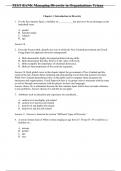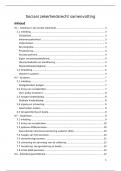TEST BANK Managing Diversity in Organizations Triana
Chapter 1: Introduction to Diversity
1. For the San Antonio Spurs, a faultline on ___________ has proven to be an advantage on the
basketball court.
A. gender
B. national origin
C. religion
D. age
Answer: B.
2. From the list provided, identify one way in which the New Zealand government and Coach
Gregg Popovich approach diversity management?
A. Both demonstrate highly developed problem-solving skills.
B. Both demonstrate that they believe in the value of diversity.
C. Both exemplify the importance of relational democracy.
D. Both are firm proponents of the creativity argument.
Answer: B. Both global views in this chapter depict the government of New Zealand and the
coach of the San Antonio Spurs initiating and participating in activities that promote diversity.
While New Zealand demonstrates this via the public and in-company ethnic programs for
businesses and organizations, Coach Popovich does it via group visits to museums with the team
as well as through conversations with his players in their own languages.
Answer choice (A) is eliminated because the San Antonio Spurs article does not make reference
to any problems. Answer choices (C) and (D) do not apply.
3. Attributes such as education and experience are considered…
A. surface level and highly job-related
B. surface level and less job-related
C. deep-level and highly job-related
D. deep-level and less job-related
Answer: C. Answer is found in the section “Different Types of Diversity.”
4. A newly formed team of White women ranging in age from 25–30 and 55–59 would have a
faultline on…
A. income
B. gender
C. age
D. race
,Answer: C. Answer is found in the section “Different Types of Diversity.” The focus of the
question is on the women’s age.
5. Apply what you know about diversity to determine which of the following statements best
describes the concept.
A. Diversity is an organization’s investment strategy.
B. Diversity is the study of faultlines.
C. Diversity is the study of gender and race differences in a group.
D. Diversity is the differences between members of a group.
Answer: D. Answer is found in the section “What Is Diversity?” Diversity is not an
organization’s investment strategy. Faultlines explain how the alignment of attributes within the
group can create sub-group level dynamics, but this is only part of what diversity is. Similarly,
diversity is more than the study of gender and race differences in a group.
6. Relational demography explains…
A. why people form relationships
B. how surface level diversity influences team communication, team processes, and team
dynamics
C. the existence of in-groups and out-groups within a team or an organization
D. that we derive part of our self-esteem from our identity groups
Answer: B. Answer is found in the section “Why Is Diversity Obvious to People?”
7. Which of the following theories or hypothesis explains how individuals classify themselves
and others into in-groups and out-groups?
A. the similarity-attraction hypothesis
B. social identity theory
C. self-categorization theory
D. relational demography theory
Answer: C. Answer is found in the section “Why Is Diversity Obvious to People?” The
similarity-attraction theory explains how homogeneous teams are predicted to work better and be
more productive because they are not diverse. The social identity theory explains that individuals
derive part of their self-esteem from their group identity. Organizational demography theory
studies how surface level differences affect team processes, performance, etc.
8. The value in diversity hypothesis proposes that diversity can benefit organizations in which
of the following ways?
A. Cost advantages, creativity, resource acquisition, marketing, problem-solving, and system
flexibility.
, B. Cost advantages, financial gains, accountability, creativity, problem-solving, and system
flexibility.
C. Cost advantages, organizational commitment, marketing, accountability, creativity, and
financial stability.
D. Cost advantages, advertising, creativity, problem-solving, resource acquisition, and
financial gains.
Answer: A. Answer is found in the section “The Business Case for Diversity.”
9. Which of the following statements is not true of the information-processing perspective?
A. Employees from diverse backgrounds who understand foreign markets are essential to a
firm’s success when the firm enters those markets.
B. A diverse board of directors and executive team who understand local laws, norms, and
culture will prove advantageous for the firm when venturing into foreign markets.
C. A diversified workforce is more likely to emphasize conforming to norms and decrease
creativity in the decision-making process.
D. A diverse workforce can help an organization process a greater amount of information.
Answer: C because this choice pertains to creativity in the decision-making process, not
processing greater amounts of information. Answer is found in the section “The Business Case
for Diversity.”
10. Which of the following statements does not reflect the optimistic view of diversity?
A. Team diversity can increase monitoring, vigilance, and lower collusion.
B. Team diversity can increase the quality and quantity of team performance.
C. Team diversity can increase the volume of information in a team at a cost.
D. Team diversity can increase firm innovation, firm reputation, and firm performance.
Answer: C. Answer is found in the section “The Positive and Negative Effects of Diversity.”
11. The French cosmetics company L’Oreal has diversified at different levels, opened offices in
more than 130 countries, and recruited international people of mixed cultural backgrounds.
Which of the following likely explains the company’s efforts to diversify its workforce?
A. Relational demography
B. Similarity-attraction hypothesis
C. Self-categorization theory
D. Information-processing perspective
Answer: D. Answer is found in the section “The Business Case for Diversity.”
12. The lack of minority coaches in the English sports leagues seems to offer support for this
diversity theory.
, A. Social identity theory
B. Social categorization
C. Relational demography theory
D. Value in diversity hypothesis
Answer: B. Answer is found in the section “Why Is Diversity Obvious to People?”
13. A successful diversity management plan needs to include the following except…
A. a strong color blind policy that emphasizes similarities and increases team harmony
B. the support of top management who must demonstrate the value of diversity
C. an accountability system where top management and managers are held responsible for
diversity outcomes
D. endorsing multiculturalism and recognizing the differences between groups
Answer: A. Answer is found in the section “Best Practices for Managing Diversity.”
14. As New Zealand’s companies venture into the international business arena, determine which
of the following would serve them best.
A. A broad understanding of relational demography theory
B. A broad understanding of the social categorization theory
C. A broad understanding of the colorblind approach to diversity management
D. A broad understanding of the information-processing perspective
Answer: D because expanding to international markets will require processing of greater
amounts of information. While the value in diversity hypothesis would help, the focus of the
latter is not to facilitate comprehension of the enormous amount of information that a company
would confront going into a foreign market. Answer is found in the section “The Business Case
for Diversity.”
15. Determine the types of diversity present in the conflict in Amsterdam regarding Black Pete.
A. separation and variety
B. separation and disparity
C. variety and disparity
D. all of the above
Answer: B. Diversity as separation refers to differences on a particular attribute such as
attitudes, beliefs, and values. This festivity is about values held by the White majority in
Amsterdam, which are questioned by some Amsterdammers. Diversity as disparity refers to
differences in status or power, which is also relevant in the case of Black Pete, as the majority in
the Netherlands is White. Diversity as variety does not apply, as it refers to professional
backgrounds, functional areas, and expertise.





